|
Hello readers and welcome back to the Hometown Heritage blog!
Many of you, like me, probably remember when Perry used to have a railway instead of a bike trail. There used to be the whistle of a train near every-day and cars would have to wait for the trains to pass. The Milwaukee Road, as evidenced in the art in the Hotel Pattee, used to pass through here as well. In fact, I found some interesting pictures about the Milwaukee Road in our collection! First, we have a picture of the last Milwaukee train to leave Perry on March 23, 1980 at 6 P.M. Although not that interesting of a photo, it shows the slow progress of the railroad leaving Perry. The next photo, however, creates some questions for me. The picture is also of the Milwaukee Road, but has a note that says it is the “Rip” Track Area. From the looks of the picture, it seems to be an empty road, with a bit of track near the bottom of the picture. This is where my questions start! I looked up what a “Rip” track is supposed to be and according to Wikipedia it is short for “repair inspect paint” track. Yet to me, it seems like there is no track here! In addition, the picture is dated to 1980, the same year when the last Milwaukee train left Perry! Perhaps this means that it is the ripping up of the train tracks in this area? It would definitely appear this way, since the area is covered in dirt and the track at the bottom is covered up. However, I do not know for sure, as our database does not provide much information. Since this happened in 1980, perhaps some of you readers may know? If you do, please let us know in the comments, and join us next week for another blog post!
1 Comment
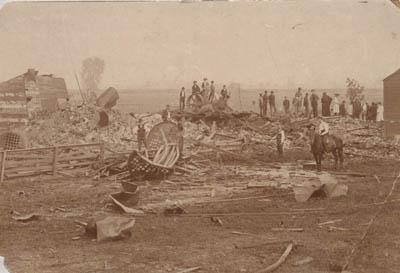 Hello Readers, and welcome back to the blog! Perry has undergone many changes over the years, some quite a bit more drastic than others. For example, did you know that there used to be a different Light and Water plant in Perry? The old Light and Water Plant was a very interesting building. First, the building is not something that we see in America today, as we separate the water works and light works into separate buildings. However, what makes the old building so interesting is what happened to the building in July 1894 and to Henry Draper. Henry Draper was the Night Operator of the Light and Water Plant, and he was on his way to work on that fateful night in July. Little did he know, Henry was never going to do any work that night. As he was on his way to work, the Plant exploded. The cause of the explosion is unknown, but as you can see in the picture, the plant was flattened. Henry was unharmed, but unfortunately the Superintendent Henry Hock was killed in the explosion. It is a very curious case, and there is no information about the explosion in our collection other than the fact that it occurred. If you know anything else about the explosion, please share with us below in the comments! As a small side story, I will tell you what happened to Henry Draper after the explosion. He became a landscaper and sexton at the Violet Hill Cemetery. He did his job exceptionally well, to the point that when the plans for the cemetery were destroyed for a time, he was the only man to know where the more than 900 dead were buried! See you all next Wednesday! Hello Readers and Happy Wednesday!
Many of you have probably heard about the new phone application that is sweeping the nation, Pokémon Go. It seems millions of people are walking around outside playing this new game. However, this game is relatively recent, and got me thinking: What were the games that brought people outside before Pokémon, phones, and any electronics at all were invented? I did some digging in our files, and found a few games that seemed to be popular in the past. First, there is the game of Horseshoes. The photo included is a picture called “Charles Challands and Friends Pitching Horseshoes”, and dates to 1934. Horseshoes was a simple, but difficult game. The goal was to throw a horseshoe from a distance and try to get it as close as you could to an upright stick in the ground. Then, you would get points based on how close you could get it! Of course, getting the horseshoe around the stick would earn you the most points, and was called a “ringer”. We have a few photos of this game, so it must have been a popular game around the 1930s and 40s. Of course, that was not the only game that was played in the past. We have another photo dated to 1920 called “Women Appear to be Playing a Dice Game, Smoking Pipes”. As you can see in the picture, there are two women looking at the ground, and it appears that they are rolling dice. Unfortunately, there is little other information about this game. What is the goal? How do you win? Or, for that matter, are they actually rolling dice? Readers, if any of you know more about this dice game, please share so we can add the information to our system! As you can see, before Pokémon Go there were plenty of other games. These games may not have swept the nation like Pokémon Go is doing, but they were still popular. It just goes to show that even without technology; people will find a way to have fun outside! 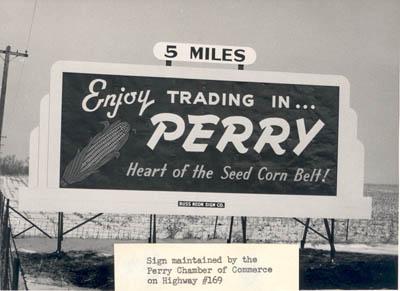 Good Afternoon Readers! Many of you have probably seen the welcome sign on the highway into Perry, but did you know that there used to be another sign directing people to Perry? It was a sign that was five miles out on Highway 169, and was very intriguing! As you can see in the picture, the sign was similar to a billboard and directed people to Perry to trade. The sign existed around 1950, and was maintained by the Chamber of Commerce. It featured a large ear of corn, which leads me to a big question that intrigues me. It calls Perry the “Heart of the Seed Corn Belt”. Personally, I have never heard of the Seed Corn Belt. It sounds similar to the Bible Belt in the South, but I have no idea what it truly means! Is it just a reference to all the corn grown in the Midwest, or is it something else? If any of you know more about it, I encourage you to tell us in the comments below! As a final word, I want to let you all know that we now have postcards for the Gary Ernest Smith Exhibition! You can find them at business around town, such as Ben Franklin’s or the Perry Perk. Or, come visit us in the Lower Level of the Town Craft Building to not only get a postcard, but see some of our wonderful collection for yourself! Hello Readers,
Today you will all be excited to know that we have finally made it to the trial of Mr. Smith! What will the verdict be? Will all get the answers to our questions about the case? Read on to find out! We start the story of the trial on September 28, 1931. In that days edition of the Perry Chief, it is announced that Smith will come to trial on Tuesday (the next day). State Agent Tullar had been travelling nearby states the previous two weeks, investigating matters related to the case. He stated that he believed the “case against Smith is now airtight.” The case was built upon a charge of conspiracy to defraud an insurance company, and it was this charge that Smith would face the next day. The trial was to begin if the proper witnesses were secured to appear. Specifically, Doctors Wittle of Clarinda and Donohoe of Cherokee were slated to appear as the first two witnesses. The next day, September 29, 1931 was the day of the trial. Perhaps surprisingly, the jury deliberated for only fifteen minutes before reaching a verdict. With a single sentence came the closing of the Smith Conspiracy: “We the jury find the defendant John M. Smith to be insane.” Judge W. S. Cooper immediately announced that Smith would be taken to the Criminally Insane Ward at Anamosa, until such time he was deemed sane upon which he would be returned to the Dallas County Sheriff for a second trial. What happened to the airtight case that Tullar was boasting about? What happened that caused Smith to be declared insane so quickly? Well, to start only Dr. Max Wittle and Dr. George Donohue were heard as witnesses before the jury. Both of these witnesses claimed unquestionably that Smith was insane. Dr. Wittle, for instance, said that Smith could not tell right from wrong, and that he was susceptible to suggestions from others who could influence him to act. Dr. Donohue said the same thing, adding that he though Smith was “too dangerous to be discharged.” Thus, the entire trial last only from 9 a.m. to 10:35 a.m., when the jury presented their verdict declaring Smith criminally insane. As if to prove the verdict, upon leaving the courthouse Smith collapsed at the bottom of the first flight of stairs. He appeared to be in a semi-conscious stupor and continually called for “Edith” his wife, even though she was with him the whole time. Many of you may be wondering if this is it. Unfortunately, it appears to be so. Even the paper says that the entire debacle is a “mystery which still has many loose ends and which will probably never be fully told.” For example, the story of the body found in the car will never be fully told. A story about Smith did reappear in May 1932, but it was a small article about an interview where Smith claimed he was the victim of a “gigantic conspiracy”, and that he remembered nothing “from the time he was bumped on the head” the night the truck was found until he was found near Garner, Iowa. You will have to decide for yourself if the jury was correct, because for now, this case, is closed. Happy Wednesday readers!
I hope that you are all surviving out there in the rain. Today we will be continuing the Smith Conspiracy Case, drawing ever closer to its conclusions. This week’s paper is from September 7, 1931, and it contains a big break-through in the case: a confession from Mrs. Smith that she was indeed involved in a conspiracy with her husband! According to the paper, County Attorney George Sackett released portions of a signed confession from Mrs. Smith after she had been grilled for more than five hours. This session occurred at the statehouse in Des Moines, and was conducted by Attorney Sackett, State Agent Tullar, Sheriff C. A. Knee and James E. Risden, the chief of the state bureau of investigation. Sackett did not release the full confession, but the portions that were released were sufficient to unquestionably incriminate both Mr. and Mrs. Smith. Two particular portions were quoted directly in the paper. First, after admitting that she had conversations with her husband about life insurance, Mrs. Smith goes on to describe one in particular. She said that “In one of those conversations he told me that he would disappear and that it would be up to me to bury him and collect the insurance. Then, after I had collected the insurance, we could communicate in some way and then go back together and live together again after a year or two. Under our plan I was to collect the insurance or accept it when paid and then meet John when he got into communication with me, which might be any time from one to two years.” Clearly, Mrs. Smith knew of the conspiracy, and was quite willing to go along with it. The second portion that was quoted in the paper indicates that Mr. and Mrs. Smith had indeed been in communication since his disappearance. Mrs. Smith said, “I received a note asking me to meet a certain party near Fremont, Nebraska, on the 19th day of June. On that day I together with my son drove to Fremont and met my husband, John M. Smith and spent the afternoon with him.” Most surprising about this meeting was that it occurred exactly four days before Mr. Smith was found on a side road near Garner, Iowa. Perhaps the two decided the conspiracy was in danger and they needed to take some kind of action. At this point, it is unclear. Unfortunately, no details were secured about how the couple procured a corpse to use in the conspiracy. Other details also remain untold, but authorities said they would be released when the proper time arrived. Another unfortunate matter is that the case against the two does not seem to be moving ahead as fast as hoped. Sheriff Knee of Dallas County said that he expected no developments on Monday, as the court in Adel was not in session. In addition, although Smith has claimed he would tell all to a grand jury, he has not appeared willing to appear before them. Despite this set back with the grand jury, it appears we are finally getting to the heart of this conspiracy! Come back next week to see if Smith and his wife finally go before the jury! Good afternoon readers!
I hope that you are all ready for yet another exciting installment of the John Smith Conspiracy! Today we will be looking at the Perry Chief for September 5, 1931. In this issue, the mental health of John Smith is once again called into question, and Mrs. Smith is returned to her home only to be questioned for four hours! The main headline of September 5’s paper reads “No Report on Smith’s Sanity.” Dr. Donohoe, one of Smith’s alienists (psychiatrists) apparently would not testify unless the court called for his appearance. Dr. Donohoe was the superintendent of the State Hospital for the Insane at Cherokee, and at the time of that paper, he was withholding his report on the matter of Smith’s sanity. In a different meeting between the doctor and the principals in the John Smith Case, Donohoe declined to discuss his findings. Meanwhile, Risden of the State Bureau of Investigation revealed a telegram in which “Dr. Donohoe claims he [Smith] is insane. I have also been advised that he was discharged from the army on the account of being insane.” If Smith was insane, Risden believed that he would be transferred to the state hospital for the criminally insane until he was declared fit for trial. Another article in the September 5th paper is about the four hour questioning that Mrs. Smith was put through. According to the article, Mrs. Smith was taken from Des Moines to her home, where Court Attorney Sackett, Sheriff Knee, and deputy sheriff Burger, Chase, and McCarthy had her open a private safe. Inside the safe were dozens of business letters and a number of letters written by Smith since he had been confined in Clarinda Hospital. They questioned Mrs. Smith of the papers for four hours, but she maintained she did not know the businessmen in the letters well enough and she still upheld her position about the fraud conspiracy. Sackett claimed that nothing of exceptional importance was found, but they kept a large amount to use as reference if it was found to later pertain to the trial. What will happen next? I bet many of you are wondering when the trial will actually start and if any progress will ever be made. I can ensure you that next time, when we will look at the September 7th 1931 paper which has the headline “Mrs. Smith Confesses Part in Conspiracy”, things will start moving. Return next week to found out what she says! Hello Readers,
Welcome back to the Hometown Heritage blog! Once again, we will be continuing the story of John Smith today. Instead of looking forward to September 1931, we will actually be taking a brief look at the July 1, 1931 paper. Although not a major headline, it is still important to the plot of the conspiracy: “Smith Ordered to Clarinda for Treatment.” At 8 p.m. on June 30, 1931, County Attorney George Sackett brought Mr. Smith before Judge E. W. Dingwell. George Sackett presented charges against Smith for “conspiracy to defraud.” Harry Wifvat, Mr. Smith’s attorney, entered a plea of not guilty. This plea was made owing to the question of Smith’s sanity, which was in question ever since he was found near Garner. Judge Dingwell ruled that Smith, because of his condition, would be order to Clarinda, a state hospital. He was to stay there for treatment, upon consent of Mrs. Smith, until the court reopened in September. It would be during September that the criminal charge would be sought if Smith had any improvement in his mental condition. If not, the question of his sanity will be brought before the court, possibly resulting in his confinement to a hospital for the criminally insane. Mrs. Smith did consent to Mr. Smith’s admission to Clarinda. She also filed a petition, seeking appointment as the legal guardian for her husband. This was so that she would be able to control his property and collect pension payments from Mr. Smith’s service during the World War. After this, county officers took Smith to Clarinda, and placed him under the care of hospital physicians. His treatment seeks to return him to a normal mental balance. Will Smith return to his normal mental faculties, if he really is insane at all? What surprises does his court case hold? Find out next time as we dive into September and the court case! Happy Wednesday readers!
I hope that you are all ready for more John Smith and his baffling case. Is Smith insane? Was he kidnapped? On the other hand, is he simply faking it as an insurance swindle? Without further ado, let us find out what happens in today’s installment! The date is June 26, 1931. Not much news has happened concerning the Smith case today, but there is a small article in the paper titled “Sackett to File Charge on Smith”. For the most part, the article discusses the charges that Smith could face and where he would be held. Unfortunately, the exact charge was not disclosed on this day, but County Attorney George Sackett did say he was ready to file charges. The thought was that charges could be pressed for conspiracy to defraud insurance companies. With these companies, Smith apparently carried policies totaling $50,000. With inflation, today that amount would be about $734,549.68. Other charges included could be related to the burning of his car and the body that he used as a decoy for himself. The biggest part of this article, however, was about Mr. Smith’s mental state. According to the article, efforts were being made to place him in a prison for the criminally insane. Dr. George Donahoe of Cherokee, state hospital for the insane, recommended that Smith be committed to the state institution for the insane. According to him, a skull fracture (the same one that originally help authorities to determine the burned body was not Smith’s) that he received 8 years ago at Norfolk, Nebraska was the cause of Smith’s mental condition. Do you agree with Dr. Donahoe? Do you think that John Smith really is insane, or is he plotting this in an attempt to get away with his crime? Find out next time, with the heading “Smith May Face Bigamy Charge”! Hello Readers,
I hope you are all ready for a ride, because we are continuing the story of the Smith Conspiracy today! This part of the story comes from the June 23, 1931 Perry Chief, which had the headline “Smith Must Face Trial in Dallas.” Early in the morning of June 23, 1931, cries and whistles coming from the road near his home, near Wilson Highway No. 15 on a byroad, attracted Charles Grau, a Hancock county farmer. He went to investigate, and what he found was quite the surprise. Lying at the side of the road was John M. Smith. His hands and feet were bound together with wire, and were connected with a rope. There was no car nearby, and Mr. Grau had not heard any car in the vicinity, so how Mr. Smith ended up there was a mystery. Grau released him, took him to his home, and called Sheriff Hanson. When the Sheriff arrived, he found that Mr. Smith was in a dazed and semi-sane condition, bordering on hysteria or insanity, but physically seemed in good condition. He was unable to give details about how he got to the vicinity, any about the apparent attack, and only talked about his wife and the truck. Sheriff Hanson did indicate, however, that Mr. Smith’s bond were loose enough that it “might not have been impossible for the man to have wired and tied himself.” The sheriff arrested Smith that day, on a warrant charging him of “conspiracy to defraud” insurance companies. Upon reaching Garner, Iowa, positive identification that this man was John Smith was provided. Harold Gesell, a fingerprint expert identified him using fingerprints from his army records. Unfortunately for authorities, Smith was not very helpful. He continually referred to his wife and his car, but appeared unable to talk about his disappearance or the incidents prior to and after the finding of the car and burned body. He claimed that three men knocked him unconscious with a blow to the head, bound him, and threw him to the side of the road, and that he had been kept in a basement for the past 5 and a half months. However, a physician failed to find any head injuries, casting doubt on the story. According to a Chief representative, Smith had lost considerable weight, was haggard in appearance, and seemed to have aged much in the five months he was missing. His mental state still appeared to be in disarray, as he was irrational and still semi-dazed. His reappearance resumed the investigation into his affairs by local insurance companies, and a question of where he was to be taken arose. The accident and burning of the other body occurred in Crawford County, but Dallas County officers carried out the case. County Attorney George Sackett stated that he would endeavor to have Smith brought to Dallas County to face charges unless Crawford officials decided to prosecute. As of the night of June 23, there was no decision on who would get custody over Mr. Smith. As you can see, the plot of this story only continues to thicken. Was John Smith actually kidnapped and held in a basement? Is he just delusional and going insane? Find out next week as the charges are laid against him! |
Archives
March 2020
Categories
All
|
All Rights Reserved, Fullhart Carnegie Charitable Trust, 2014-2023
This website is possible with the support of the
Dallas County Foundation
This website is possible with the support of the
Dallas County Foundation

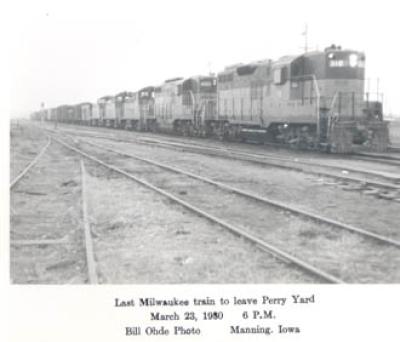
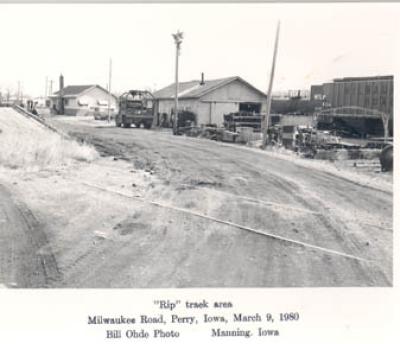
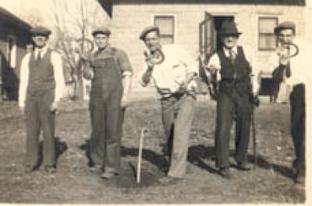
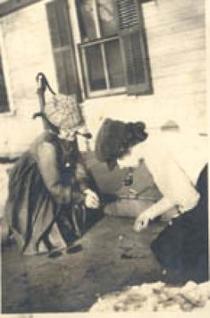
 RSS Feed
RSS Feed